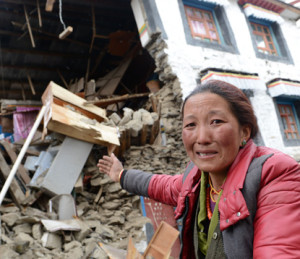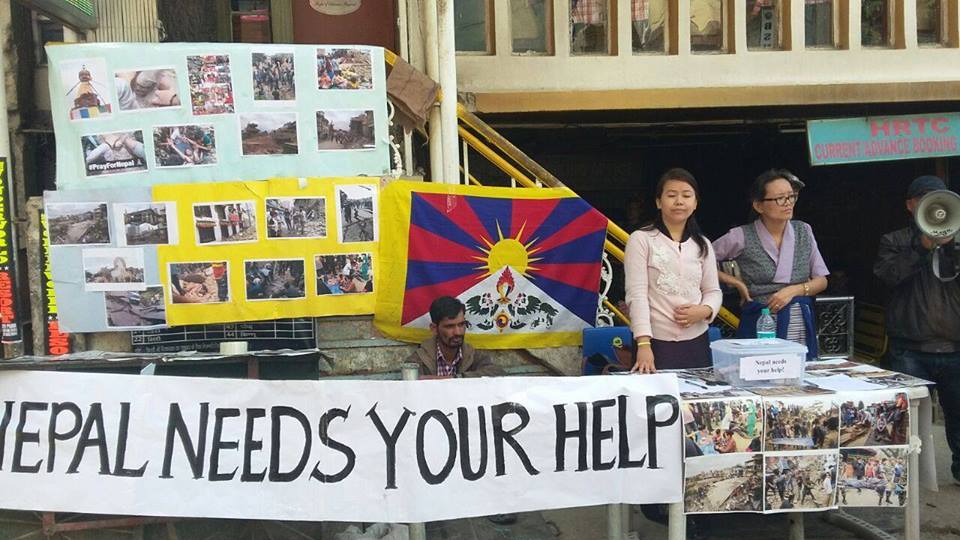A devastating earthquake of 7.9 on the Richter scale hit Central Nepal, together with neighbouring areas of Tibet and northern India, on April 25. At the time Contact goes to press, the estimated death toll is 10,000 with over 10,000 injured and many Tibetans are among those affected. Nepal is home to a sizeable Tibetan refugee community and a number of Buddhist monasteries.

A Tibetan women in Tibet crying after her house was destructed by the earthquake
Photo: The Washington Post
The destructive impact of the earthquake spread into neighbouring Tibet, including the counties of Nyalam, Kyidrong, Dingri, Drongpa, Dromo, Lhatse, and Ngari’s Purang. Reports indicate that the death toll in Tibet has reached twenty; 58 people have been injured; four continue to be missing and 12,000 others have been evacuated. There has been extensive damage and many people are being evacuated to Lhasa, not knowing if they will ever be able to return home.
The Central Tibetan Administration (CTA), or the Tibetan Government-in-Exile, has reported that as far as Tibetans in Nepal are concerned, despite much damage to property, there are only three reported fatalities to date. Currently, almost all Tibetans in Nepal are staying in tents in open areas, fearing more aftershocks.
Expressions of sympathy and support have been pouring in. His Holiness the Dalai Lama said “The people of Nepal and Tibetans have been neighbours throughout history and many Tibetan refugees live in Nepal. I offer my condolences to you and to those who have lost members of their families, friends and their homes in this tragedy.” He added that he has asked the Dalai Lama Trust to make a donation towards rescue and relief efforts. His Holiness the 17th Gyalwang Karmapa has sent 100 tents to shelter homeless people and 5,000,000 Nepali rupees towards food and other necessities, saying “We dedicate the merit of these donations that all sentient beings be free from suffering and the causes of suffering”. The Tibetan Government-in-Exile has donated INR 20 lac, saying it “is immensely concerned by these tragic developments and takes this opportunity to express sympathy and condolences to the victims.”
Tibetans have held prayer services for the victims in Tsuglakhang, the main temple in Dharamshala, and across India and Nepal.
Tibetan non-government organisations (NGOs) are also contributing to the relief efforts. The National Democratic Party of Tibet, Tibetan Women’s Association, Gu-Chu-Sum, Students for a Ffree Tibet and Tibetan Youth Congress, Dharamsala, have been raising funds in the main square in McLeod Ganj throughout the week following the earthquake. Tibetan Youth Congress (TYC) executives have travelled to Nepal where they will work with Nepali TYC chapters and local NGOs. They will also check on the situation of Tibetans living in Nepal. Many Tibetans living in exile are giving their time and money to help with relief work on an individual basis and in Delhi, the Tibetan Welfare Office in Delhi and the Samyeling Tibetan Colony Head have held prayers and are fundraising.
In a very practical way, Tibetan monks have been picking up their tools and helping to dig people out. Many more Tibetans have also been distributing food, water, bedding and other necessities.
The BBC has raised concern about the many Tibetans living in Nepal, of whom only a minority have Nepalese citizenship. It says that many of them are living illegally and do not have residency rights or identity cards. They are stateless and therefore invisible. The BBC asks how can authorities be sure about the precise number of victims, or even know where to search for victims among the Nepalese population, when there are tens of thousands of undocumented refugees?
Nepal is particularly prone to earthquakes. It sits on the boundary of two massive tectonic plates – the Indo-Australian and Asian plates. It is the collision of these plates that has produced the Himalaya mountains, and with them, earthquakes. Scientists are warning that the earthquake and its aftershocks have probably triggered many landslides, which could still cause devastation to settlements and infrastructures downstream.
As April draws to a close, aid is reaching remote regions such as Dhading and Gorkha near the epicentre of the earthquake. Some villages are only accessible by helicopter, or a walk of several hours. Many survivors are in desperate need of food and water and thousands are queuing to leave the capital, Kathmandu, fearing epidemics.
Nepalese officials have denied reports from some international charities that Western tourists were given priority during evacuations from around Mount Everest, where the ‘quake triggered an avalanche that killed at least 18 people. All stranded climbers have now been evacuated from the base camp.
And in Kathmandu, amid the widespread chaos and suffering, there was a hint of joy when soldiers rescued a four-month old baby who had been trapped alone under the rubble for 22 hours.





 Print
Print Email
Email